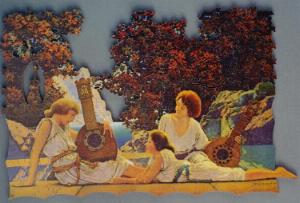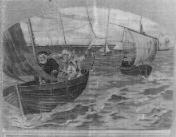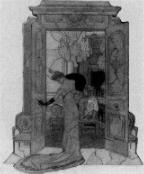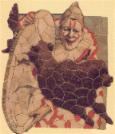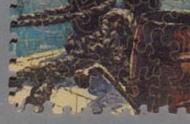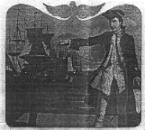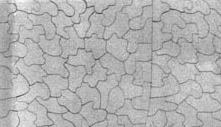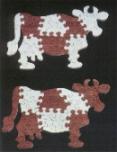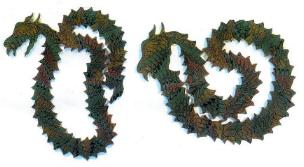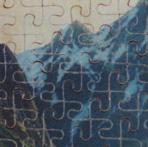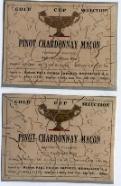Copyright 2001 by Bob Armstrong
The article below was published 2002 in three parts (volume 3, numbers 1-3) of Game & Puzzle Collectors Quarterly (ISSN - 1529-4706), the official publication of the Association of Game & Puzzle Collectors. It is reprinted here, with slight changes to make it easier to view on the web.
In my article titled Jigsaw Puzzle Cutting Styles: A New Method of Classification I identified (but did not discuss) eleven other special techniques employed in jigsaw puzzles made for adults [1]. Since then I have become intrigued with the many special techniques used in making puzzles and their history over the past 240 years. In this article, I will identify 38 special techniques and in my best judgment, when they were first used and the actual maker(s) who employed them. By special techniques I mean practices used by the puzzle maker in cutting a jigsaw puzzle and intended by the maker to:
-deceive the assembler
-make a puzzle more interesting, unusual, personal or challenging, or
-enhance the enjoyment of assembly or the impact of the scene.
While the effect of the technique upon the assembler is important, I am particularly stressing the intent of the maker, the fact that he/she has intentionally used a technique to achieve a desired effect.
In the interest of brevity, I am omitting: puzzles emphasizing marketing themes (i.e. advertising, double picture, mystery, riddle, game, extra pieces); childrens puzzles; block, metamorphic, marquetry,[2] mosaic and bevel puzzles. Since my discussion is based mostly upon American puzzles and involves considerable subjectivity, the reader may well disagree with my selections and conclusions and have information on puzzles unknown to me. I invite you to send me your thoughts on techniques which you think should be included and the puzzles and makers/brands which you believe predate the earliest use I have identified, or even if made in the same era, should be added to my short list of maker/brand[3].
Identification of earliest use and maker/brand is based primarily upon the files of Anne Williams and the Armstrong family, which, together, contain information on over 10,000 jigsaw puzzles. Where there is commonality among techniques, I have grouped and discussed them together. In many of the examples pictured on this page, the appropriate feature has been magnified so that the feature can be seen here. For all examples, clicking on the picture will lead to a page with a much larger picture of whole puzzle. The examples in this article are of: puzzles in the private collections of Williams and Armstrong, puzzles pictured in Williams book[4], and puzzle pictured in books written by others[5]. Still, a copy of Williams book nearby for quick reference would be helpful as you read the article. In addition, Conrad Armstrong (my son) has cut a 145 piece puzzle designed to illustrate 21 of the special techniques. Finally, for handy reference, I have developed a chart summarizing the 38 special techniques, their earliest use and by whom, and listing where they are displayed.
Discussion of Special Techniques
|
Perhaps the most widely (and earliest) used special technique for cutting jigsaw puzzles and #1 on my list is color line cutting. This technique of cutting along color separations within a puzzle was employed by John Spilsbury, London, England in the very first puzzles made by him in the 1760s when he cut along the national borders in his map puzzles for children[6]. Not surprisingly, when Charles Jefferys, Philadelphia, PA started cutting some of the very first adult puzzles in America in the late 1890s, he employed color line cutting (Example 1). Following Jefferys puzzle makers in what is called the 1909 era used color line cutting extensively, more so than in any subsequent puzzle era [7]. |
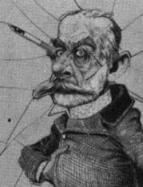 Example 1. Color line cutting |
|
Another basic technique, which I refer to as figure pieces but also known as figurals, silhouettes, whimsies, key or character pieces, was first employed early in the 20th century for adult puzzles and has undergone several refinements leading to nine variations seen today[8] (#2a-2i). Figure pieces are specially cut pieces of the puzzle (usually using a pattern), which resemble recognizable objects such as animals, people, geometric figures, letters, numbers, household items, etc. Parker Brothers, Salem, MA made extensive use of a simple form of normal figure pieces in its early Pastime puzzles starting in 1910[9] (Example 2a). Parker Brothers (Pastime line) also made first use in America[10] of figure pieces-enhanced where dead end cuts are made into the figure to add detail (Example 2b). By the 1920s, Harriet Eagleson, Watertown & Arlington, MA and someone known only as Damon were cutting individual figure pieces into several puzzle pieces thereby creating figure pieces-complex[11] (Example 2c). Par Company, New York, NY began cutting the intended owners initials, personal dates and favorite items into its puzzles in the 1930s resulting in figure pieces-personalized [12] (Example 2d). This special technique is widely used in puzzles cut today[13]. For a more generalized form of personalization, in the 1930s Tuck (Zag-Zaw line) started cutting into some of its puzzles messages such as Happy Birthday or Dear Mother, called figure pieces-messages (Example 2e). Only a few cutters of the 1909 era consistently cut into their puzzles the same figure piece to identify themselves as the maker, starting with the letters J and L (Jig-Leo) of Lee Olney, Bath, Me and Pinehurst, NC (Example 2f) and later with the swastika of Helen Haskell Noyes, New York, NY[14]. This technique, called figure pieces-signature, is quite common today allowing accurate identification of a puzzles maker even if the box is lost. By the 1920s Parker Brothers (Pastime line) began to select and locate figure pieces within a puzzle appropriate to the scene, which I call figure pieces-appropriate (Example 2g). While Parker Brothers, Tuck and Par led the way in developing several techniques of cutting figure pieces, the Jones family, Chagrin Falls and Cleveland, OH cut some of the most extraordinary puzzles in the 1930s literally filled with exquisite figure pieces[15], many of them placed so as to appear to be interacting with each other and called figure pieces-interactive (Example 2h). The last of the nine special techniques for figure pieces is also the last to be developed: figure pieces-rebus, first employed by Stave Puzzles in the 1980s (Example 2i) and seldom appearing in other makers puzzles. A rebus is a series of carefully selected and cut figure pieces which, if properly read together, will form a word, phrase or expression. |
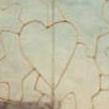 Example 2a. Figure pieces-normal 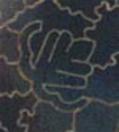 Example 2b. Figure pieces-enhanced 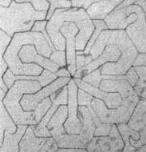 Example 2c. Figure pieces-complex |
||
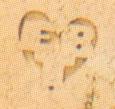 Example 2d. Figure pieces-personalized |
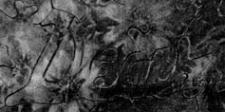 Example 2e. Figure pieces-message |
 Example 2f. Figure pieces-signature |
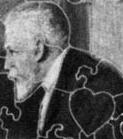 Example 2g. Figure pieces-appropriate |
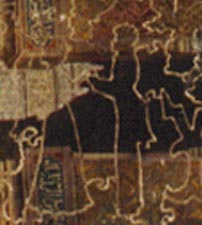 Example 2h. Figure pieces-interactive |
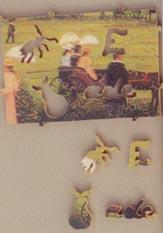 Example 2i. Figure pieces-rebus |
|
While irregular edges involve cutting away parts of the outside of a puzzle, the basic technique of dropouts refers to cutting and leaving out areas within the puzzle borders (#4a-4e) . This can be done: to accentuate the central image thereby enhancing the scene, resulting in dropouts-enhancement which Par Company, New York NY and an obscure maker known only as Adreko did in the 1930s (Example 4a); to deceive the assembler with many small missing areas forming dropouts-deception which Stave Puzzles, Norwich, VT first started doing in the 1990s[16] (Example 4b); to create figures from the remaining pieces adjacent to the dropout areas, called dropouts-figures which Par Company, New York, NY first employed in the 1930s[17] (Example 4c); to create open areas within the puzzle which by themselves look like recognizable objects, called dropouts-sculpting, which Par Company also started doing in the 1930s (Example 2d)[18]; or to create multiple unattached figures which can be rearranged many ways but will fit in the puzzle in only one arrangement, called dropouts-challenge which Stave Puzzles developed only recently in the 1990s (Example 4e). Dropouts-enhancement is common today, but dropouts-deception, figures, sculpting and challenge require much planning and careful execution and are employed by only the best makers. |
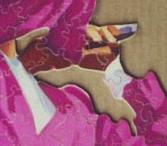 Example 4a. Dropouts-enhancement |
|
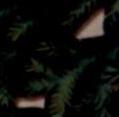 Example 4b. Dropouts-deception |
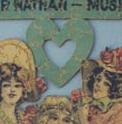 Example 4c. Dropouts-figures |
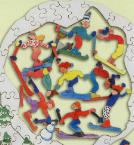 Example 4e. Dropouts-challenge |
|
Minor changes in the makers cutting practices can produce four related techniques which will increase the level of a puzzles difficulty (#5a-5d). Disguised edges, i.e. pieces which do not resemble edge pieces but are needed to assemble the edge, were employed in non-interlocking puzzles (push-fit) in 1909c. by Kiltime Puzzles (address unknown), and in interlocking puzzles in the 1920s by The Original Thread & Needle Shop, Boston, MA (Example 5a) [19]. This technique is designed to confuse the assembler who habitually separates all the edge pieces and assembles them first before tackling the rest of the puzzle. Closely related are inside edges, corners, i.e. pieces, which look like edges and corners but assemble within the puzzle itself. Again, Charles Jefferys, Philadelphia, PA was using this technique in his early adult puzzles of the late 1800s (Example 5b). Kiltime Puzzles and Original Thread & Needle Shop were also making split corners in 1909c. and the 1920s respectively, by cutting through the actual corners of their puzzle (Example 5c)[20]. The fourth technique in this group, split knobs, occurs when the maker cuts pieces with large knobs and then cuts right through the knob itself making two pieces, thereby confusing the assembler who is looking for one piece with a full knob. European puzzles of the late 19th century feature this technique, probably the result of the cutting pattern employed at that time[21]. Bert Rowe (address unknown) cut a wonderful example in the 1930s (Example 5d). Combining several of these techniques in one puzzle will raise the level of difficulty and make a puzzle very challenging to assemble, especially if started from the edge. |
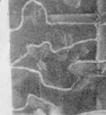 Example 5a. Disguised edges |
||
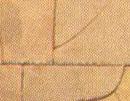 Example 5b. Inside edges/corners |
 Example 5c. Split corners |
 Example 5d. Split knobs |
|
|
While traditional jigsaw puzzles are two-dimensional, I have identified three special techniques for adding a layered look to a puzzle, sometimes referred to as three-dimensional (#6a-6c). Multiple level puzzles involve adding (or subtracting) a layer of plywood (or ply). Most commonly, two pictures are used and cut into puzzles separately with the picture for the top level cut smaller than the bottom level (usually by discarding background). The smaller puzzle is then placed exactly over the same portion of the image in the larger puzzle and selected key pieces glued together between the two puzzles, thereby anchoring the top puzzle onto the bottom puzzle. I call this multiple levels-same picture, a technique first employed by Joseph Straus, Brooklyn, NY in its Sculptured series in the 1930s using two copies of the same picture[22] (Example 6a). If different scenes are used, the top picture must be carefully selected, cut and anchored onto the bottom picture so as to fit in to the overall scene, called multiple levels-different pictures, a technique Stave Puzzles developed in the 1980s (Example 4b)[23]. A variation employed by Straus in the 1930s used only one scene but raised the central image by gluing onto the central images bottom only, plywood carefully matching the outline of the central image, i.e. multiple levels-same wood. As a result of my efforts to encourage puzzle cutting in Pushkin, Russia in the early 1990s[24], Michail Drugov not only raised the central image this way but also shaved off two layers of ply from the backs of figure pieces cut in the puzzle, thereby creating an ingenious three-level puzzle from one picture with no overlapping sections (Example 6c). |
||
 Example 6a. Multiple levels-same picture |
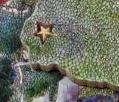 Example 6b. Multiple levels-different picture |
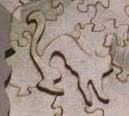 Example 6c. Multiple levels-same wood |
|
Loose cut puzzles, the result of the use of thicker blades during cutting, normally are not considered well cut puzzles by most American collectors and enthusiasts[25]. Yet, Stave Puzzles, Norwich, VT has developed a highly refined version of this concept and created its own trademarked Crazy Claws and Monkey Fist. As I understand it, a very experienced cutter will cut a slightly larger round hole into which several other round knobs will loosely fit. The loose fit may allow the adjacent piece to shift as in Crazy Claws or pieces from other parts of the puzzle to fit into the hole as in Monkey Fist (Example 8). When integrated into specially designed artwork, the effect tricks the assembler into following many false paths, similar to double cutting. I call this technique loose cut-challenge (#8). |
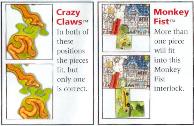 Example 8. Loose cut-challenge |
|
Collage puzzles (#10) cover a broad range of puzzles where the picture itself has been altered in some manner by the puzzle maker. There are so many ways of doing this that I have not tried to identify each as an individual special technique. They include: attaching stickers to the picture before cutting (Andover Novelty Shop, Andover, MA 1930s Nu-Friend puzzles-Example 10a); cutting the plywood larger than the picture and painting and cutting the bare wood attached to or separate from the puzzle (Clyde Richburg, North Andover, MA, 1930s Novelty puzzles-Example 10b); combining sections of several pictures to create a composite scene[26]; touching up the picture with paint or colored pencils; revising or shortening the picture by double cutting sections and relocating key elements in the scene and discarding areas in between (my own The Magic of Mozart 1991 puzzle-Example 10c[27]). Collage techniques allow a maker to change to some extent the existing scene. This is important because, historically, nearly all puzzle makers have worked with existing artwork and cut the puzzle to the picture. A few makers have produced their own original art or hired someone else to produce it but generally have still cut the puzzle to the picture. In 1977 Stave Puzzles, Norwich, VT began reversing this process by designing the puzzle first and then commissioning an artist to draw the picture in accordance with the puzzle designers specifications. Multiple copies of the artwork are then made and cutters trained to cut puzzles individually from the artwork in accordance with the original design specifications. While expensive, this approach (not really a special cutting technique) opens the way for imaginative use of new techniques as well as further refinement of existing ones. |
||
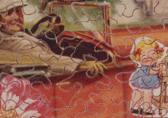 Example 10a. Collage puzzles |
 Example 10b. Collage puzzles |
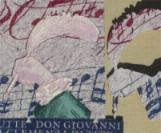 Example 10c. Collage puzzles |
|
The last group of techniques for discussion are puzzles which truly have a three dimensional quality (#12a-12c). They include: 3-D pop up where special pieces are made and stood up by fitting into pre-cut slots in the puzzle (Stave Puzzles, Norwich, VT 1970s-Example 12a); 3-D constructional where the assembler actually builds a replica or model in three dimensions by fitting jigsaw-like pieces together (Kawin Mfg. Co, Astoria, NY/Skyline 3-D, 1930s-Example 12b), and 3-D puzzle to game where after assembly pieces of the puzzle can be removed and turned into a game such as ring toss (Harper Novelty Co, England/Toyzenet, WW I-Example 12c). The 3-D constructional puzzle is popular today in the form of foam block pieces, which can be assembled into some of our most famous buildings and landmarks in the world. At this point, the jigsaw puzzle is becoming mechanical in nature and crossing into the broad field of mechanical or solid puzzles and its many variations[28]. |
||
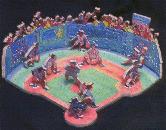 Example 12a. 3-D pop up |
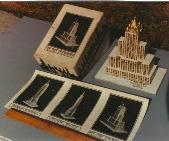 Example 12b. 3-D constructional |
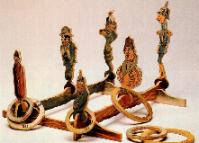 Example 12c. 3-D puzzle to game |
Conclusion
For collectors, finding and acquiring examples, especially early examples, of the 38 techniques listed should prove to be a stimulating challenge and new focus for your collecting activities. I am confident there are earlier and/or better examples of several listed in my discussion and I would appreciate hearing from you as you find them. For cutters, expanding your skills and repertoire to include some of the techniques discussed should prove an interesting challenge. I believe income and sales will increase accordingly. For sellers, pointing out the special techniques employed in the puzzles you list for sale (especially on ebay.com) should attract more buyers and higher prices. It is not by accident that the leading innovator of special techniques on my chart is Stave puzzles with eight, followed by Par Company with five. The puzzles of these makers are generally considered the best cut and most desirable puzzles on the market today commanding the highest prices. And for Stave Puzzles to have developed at least eight special techniques more than 200 years after the first puzzles were cut and following the accomplishments of Par and others, is truly amazing. It demonstrates that not everything has been invented in the jigsaw puzzle world and we can look forward to new techniques and interesting puzzles in the future.
Acknowledgments
Special acknowledgment must be given to Anne Williams for her continuing support, information and suggestions, and especially for her time in reviewing her own collection and data base for earliest uses and supplying me with copies of many of the examples displayed. Thanks also go to Conrad Armstrong who identified several of the techniques listed and then cut a special puzzle demonstrating 21 of them. Finally, none of this would have been possible without the indulgence of my wife, Hildegard, who allows me to take over several rooms of our large home in Worcester, MA for collection, restoration, study and display of puzzles.
Summary Table
| # | Technique | Description | Earliest Use | Maker/Brand |
|---|---|---|---|---|
| 1 | Color line cutting | cutting along color separations in scene | 1898 | Jefferys; most makers 1909c. |
| 2a | Figure pieces-normal | piece shapes resemble recognizable objects | 1909c. | Parker/Pastime; others |
| 2b | Figure pieces-enhanced | deadend lines cut into figure to add detail | 1930s | Parker/Pastime |
| 2c | Figure pieces-complex | figurals cut into multiple pieces | 1910/20s | Eagleson; Damon |
| 2d | Figure pieces-personalized | owner's initials, dates, favorite items cut in | 1930s | Par |
| 2e | Figure pieces-message | general messages ("Dear Mother") cut in | 1920s | Tuck/Zag-Zaw |
| 2f | Figure pieces-signature | special figurals identifying maker | 1909c. | Olney/Jigleo; Noyes/Swastika and Keyes (later) |
| 2g | Figure pieces-appropriate | relate to scene and location | 1920s | Parker/Pastime; unknown makers earlier |
| 2h | Figure pieces-interactive | relate to each other meaningfully | 1930s | Jones/Falls |
| 2i | Figure pieces-rebus | "reading" figurals identifies word or expression | 1970s | Stave Puzzles |
| 3a | Irregular edges-not straight | wavy, scalloped, jagged, geometric | 1898 | Jefferys; many makers 1909c. |
| 3b | Irregular edges-outline | edge cut following outline of scene objects | 1909c. | Bouve |
| 3c | Irregular edges-protrusion | regular cut in leaving scene object "protruding" | 1909c. | Whatami |
| 3d | Irregular edges-knobs | puzzle edges follow knob style of puzzle | 1930s | Sargent |
| 3e | Irregular edges-figures | edge cut away leaving figural(s) | 1930s | Par |
| 4a | Dropouts-enhancement | background omitted w/i puzzle outlining scene | 1930s | Par; Adreko |
| 4b | Dropouts-deception | multiple small areas omitted to deceive | 1990s | Stave Puzzles |
| 4c | Dropouts-figures | remaining pieces form recognizable objects | 1930s | Par |
| 4d | Dropouts-sculpting | omitted areas form recognizable objects | 1930s | Par |
| 4e | Dropouts-challenge | remaining figurals rearrangeable many ways-1 fits | 1990s | Stave Puzzles |
| 5a | Disguised edges | edges abut point/interlock with inside piece | 1909c./1920s | Kiltime (nonlk);Original Thread & Needle Shop (lk) |
| 5b | Inside edges, corners | located within puzzle | 1898 | Jefferys |
| 5c | Split corners | puzzle cut at or near corners | 1909c./1920s | Kiltime; Original Thread & Needle Shop |
| 5d | Split knobs | pieces with knobs cut in half thru knob | 19th cent. | "swastika" cutting style; in US: Rowe (1930s) |
| 6a | Multiple levels-same pictures | all levels form same scene | 1930s | Straus/Sculptured; Gold Seal/Locktite |
| 6b | Multiple levels-different picture | levels differ but complement each other | 1980s | Stave Puzzles |
| 6c | Multiple levels-same wood | ply layers increased/decreased for main image/figs | 1930s | Hayter/Victory/Construcional; Straus/Sculptured |
| 7a | Double cutting-sections | sections cut together--pieces interchangeable | 1930s | Fiss |
| 7b | Double cutting-deception | pieces partially double cut to deceive | 1909c. | Helmore & Tassell/Maids of Kent (1920s) |
| 7c | Double cutting-reversing pieces | puzzle double cut face-to-face; sections exchanged | 1980s | Stave Puzzles |
| 7d | Double cutting-challenge | puzzle can assemble different ways (only 1 right) | 1990 | Stave Puzzles |
| 8 | Loose cut-challenge | multiple knobs fit loose cut holes | 1990s | Stave Puzzles |
| 9 | All pieces same shape | all pieces (except edges) look identical | 1930s | Perx |
| 10 | Collage puzzles | picture changed, enhanced, extended, touched up | 1930s | Andover/Nu-Friend; Richburg/Novelty |
| 11 | Two-sided puzzles | pictures on both sides-same or different | 1909c. | Austen Co; Williams |
| 12a | 3-D pop up | figure pieces fit standing up into puzzle surface | 1970s | Stave Puzzles |
| 12b | 3-D constructional | pieces build replica of buildings, objects, etc. | 1930s | Kawin/Skyline 3-D |
| 12c | 3-D puzzle to game | pieces can be assembled into puzzle or game | 1910s | Harper Novelty/Toyzenet |
References
Armstrong, Bob. To Russia-with Puzzles, Game Times, Issue #21. American Game Collectors Association (August 1993) 452-453.
Armstrong, Bob. Jigsaw Puzzle Cutting Styles: A new Method of Classification, Game Researchers Notes, Issue No. 25. American Game Collectors Association (February-May 1997) 5581-5590.
Bekkering, Betsy and Geert. Piece by Piece: A History of the Jig-Saw Puzzle in the Netherlands. Amsterdam: Van Soeren & Co. 1988.
Hannas, Linda. The English Jigsaw Puzzle 1760 to 1890. London: Wayland Publishers 1972.
Hannas, Linda. The Jigsaw Book. New York City: The Dial Press 1981.
Stave Puzzles Catalog. Norwich, VT. 2000/01.
Williams, Anne D. Jigsaw Puzzles: An Illustrated History and Price Guide. Radnor, PA: Wallace-Homestead Book Co. 1990.
Williams, Anne D. Parker Brothers and Pastime Puzzles, Cutting a Fine Figure: The Art of the Jigsaw Puzzle. Lexington, MA: Museum of Our National Heritage 1996.
Wolkomir, Richard. The Rolls-Royce of puzzles drives its fans around the bend, Smithsonian Magazine (May 1990) 104-111.
[1] Armstrong (1997, p. 5588). See References for complete citations.
[2] Marquetry puzzles depend upon the color grains of different types of wood to paint the picture and can resemble the traditional jigsaw puzzle, as with puzzles of Steve Malavolta, Albuquerque, NM. This is a different area involving special woods and exceptionally fine craftsmanship, material for another article.
[3] Email: or mail: Bob Armstrong, 15 Monadnock Road, Worcester, MA 01609 or call: 508-799-0644.
[4] Williams (1990).
[5] Bekkering (1998); Hannas (1972); Hannas (1981).
[6] Williams (1990, Fig. 1-1).
[7] Williams (1990, pp. 11-12).
[8] The roots of figure pieces actually originated with childrens die cut puzzles of the 19th century. In the late 1860s, Milton Bradley, Springfield, MA used identically shaped pieces (circles and hexagons) so that the assembler would learn the parts of a ship or locomotive. And other makers would cut around a figure in the picture such as a horse or cow, thereby creating a figure piece with artwork appropriate to the figure.
[9] Williams (1990, pp. 12-13).
[10] Raphael Tuck & Sons, London, England was cutting mouths into the faces of animal figure pieces in some of its puzzles using a single dead end cut as early as the 1920s.
[11] Parker Brothers, Salem, MA was cutting circles within circles in its Pastime puzzles in the 1910s. See http://www.oldpuzzles.com/Examples/detail.php?id=p297.
[12] Williams (1990, p. 34).
[13] Par Company used several different styles of lettering for the intended owners initials or name in a puzzle. A new style has recently been developed by Melinda Shebell, Stow, MA whereby she has been able to write a name in script using carefully placed kerfs between pieces and dead end cuts. Examples are displayed on her web site at: <www.jardinpuzzles.com>.
[14] Williams (1990, Fig. 10-6).
[15] So filled with delicate figures and intricate cutting, Falls puzzles are highly susceptible to damage.
[16] I did find an Isabel Ayer/PPE puzzle cut in the late 1930s which contains a single suspicious small hole amidst tree foliage and neatly deceived me, but this probably is a cutting error by Ms. Ayer near the end of her long and distinguished career and hardly compares with the extensive use by Stave Puzzles of dropping out multiple small areas in specially selected scenes with such deceptive effect.
[17] Williams (1990, p. 34).
[18] Exhibit 2d demonstrates dropouts-sculpting as well as figure pieces-personalized and dropouts-figures. Williams (1990, Fig. C-37).
[19] Exhibit 5a also employs split corners.
[20] Exhibit 5c also employs disguised edges.
[21] Bekkering (1988, p. 70).
[22] Gold Seal Toy Co., Dundee, IL developed a variation using only one picture and filling in the covered sections in the lower levels with patterned wrapping paper. Williams (1990, Fig. 10-21).
[23] Exhibit 4b demonstrates dropouts-deception as well as multiple levels-different pictures.
[24] Armstrong (August 1993).
[25] On the contrary, most English puzzles are considerably looser than their American counterparts. Since exposure to dampness tightens a puzzle over the years and England is renowned for its damp climate, the makers of English puzzles may have compensated for the inevitable swelling by cutting looser puzzles.
[26] Stave Puzzles creates a family tree puzzle with pictures of the buyers family incorporated into branches of the tree. Stave Catalog (2000-01, p. 36).
[27] Conrad Armstrong also used this approach about the same time in cutting his award winning Life Under the Sea puzzle http://www.newpuzzles.com/lifesea.htm
[28] Jerry Slocum, Beverly Hills, CA has just completed an excellent series of articles in Game & Puzzle Collectors Quarterly, beginning with its Spring Issue (March 2001), which introduce the wide variety of mechanical puzzles.
